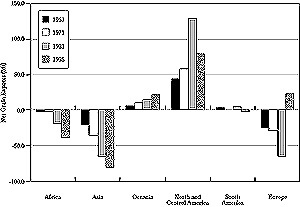11.2.2.2. Grain Supply and Demand in Asia

Figure 11-8: Trends in net grain exports in major world regions (USDA,
1999). |
Asia's total cereal production more than tripled
between 1961 and 1999, from 329.5 to nearly 1,025.8 Mt; the increase in harvest
area was only marginal (from 271.8 to 324.5 Mha) during this period. Rice paddy
production in Asia jumped from 198.7 to 533.5 Mt while the harvest area increased
from 106.9 Mha in 1961 to 136.5 Mha in 1999. Similarly, wheat production in
Asia increased from 45.8 to 261.7 Mt while the harvest area increased from 61.2
Mha in 1961 to 97.2 Mha in 1999. A three-fold increase in production of sugarcane
and almost five-fold increase in oil crops took place in Asia during 1961-1999.
Asian production of starchy roots also doubled during this period. Even as the
Asian population increased a little more than two-fold—from 1.70 billion
to 3.58 billion people—during this time, per capita consumption of calories
in Asia has increased since the 1960s (FAO, 1999a). This improvement in the
food situation has been the consequence of an increase in production, resulting
from technological advances, that has outpaced population growth in Asia. However,
because there is a limit to the amount of arable land, while the Asian population
continues to grow, the per capita area of harvest has consistently decreased.
The population growth rate has been a primary factor in the increase in demand
for food grains in Asia. Since the mid-1980s, rapid changes in food supply and
demand structures have been observed in most developing countries. Declines
in self-sufficiency for grains have been particularly dramatic in countries
with advanced economies, such as Japan, South Korea, Taiwan (China), and Malaysia,
where the grain self-sufficiency rate has fallen below 30% in recent years.
The rapid decline in grain self-sufficiency in these countries is unprecedented
in any region of the world. Between 1970 and 1996, grain self-sufficiency fell
from 45 to 27% in Japan, from 68 to 31% in Korea, from 61 to 19% in Taiwan (China),
and from 60 to 25% in Malaysia (FAO, 1996). Declines in grain self-sufficiency
also have been observed in the Philippines, Indonesia, and Sri Lanka. Populous
countries such as China, India, Bangladesh, and Pakistan have long maintained
grain self-sufficiency of more than 90%, but as these countries shift to industrialization
it is possible that declines will be observed there as well. In contrast, Thailand
and Vietnam, which encompass the great grain-producing regions of the Menam
and Mekong River deltas, continue to maintain better than 100% self-sufficiency
for grains.
The annual per capita consumption of meat in principal Asian countries also
has shown an upward trend in recent years. Since the 1970s, South Korea and
China have reported the most rapid increases in meat consumption. In South Korea,
per capita meat consumption grew about seven-fold, from 5.2 to 40 kg between
1970 and 1997; in China, it increased nearly five-fold, from 8.8 to 42.5 kg.
During the same period, per capita meat consumption more than doubled in Japan
(42.2 kg in 1997) and Malaysia (51.9 kg in 1997). Meat consumption in Sri Lanka,
Bangladesh, and India grew only marginally, remaining below or at 5 kg even
in 1997—considerably lower than the level in east Asia. The increasing
trend in meat consumption in temperate Asia means higher demand for livestock
feed for the production of meat. Demand for this feed in Asia increased from
25.2 Mt in the 1970s to 61.2 Mt in 1980, 147.0 Mt in 1990, and 163.0 Mt in 1999.
The demand for feed grain in Asia has grown at an annual rate of about 6.6%
and has been a principal factor in the rapid increase in demand for world grain
imports.
The world is moving toward a tighter grain supply and demand, and instability
in the world grain market is rising. At the same time, Asia is becoming increasingly
dependent on the world grain market. As shown in Figure 11-8,
net grain import in Asia was 20.3 Mt in 1961; it increased to 80.9 Mt by 1998.
The continuing increase in grain imports is a result of increasing populations
and increased demand for grain that accompanies economic growth, with which
increases in grain production within the region cannot keep pace.
The impact of global warming on the international supply and demand of rice
and wheat has been evaluated by Nakagawa et al. (1997) through the use of a
partial equilibrium-type dynamic model for world supply and demand. Based on
a world rice and wheat supply and demand model and a unit harvest scenario,
the study projected that the serious impacts of global warming would be felt
as early as the year 2020. The study suggests that the early impacts will not
be so severe that humans are unable to control them. However, the gap between
supply and demand may grow in some regions of Asia, resulting in considerably
increased reliance on imports. Furthermore, the problem of short-term fluctuations
in the market because of an increased frequency of droughts, floods, and other
extreme weather events will be exacerbated, making it necessary to promote measures
to combat climate change on a global scale.
|